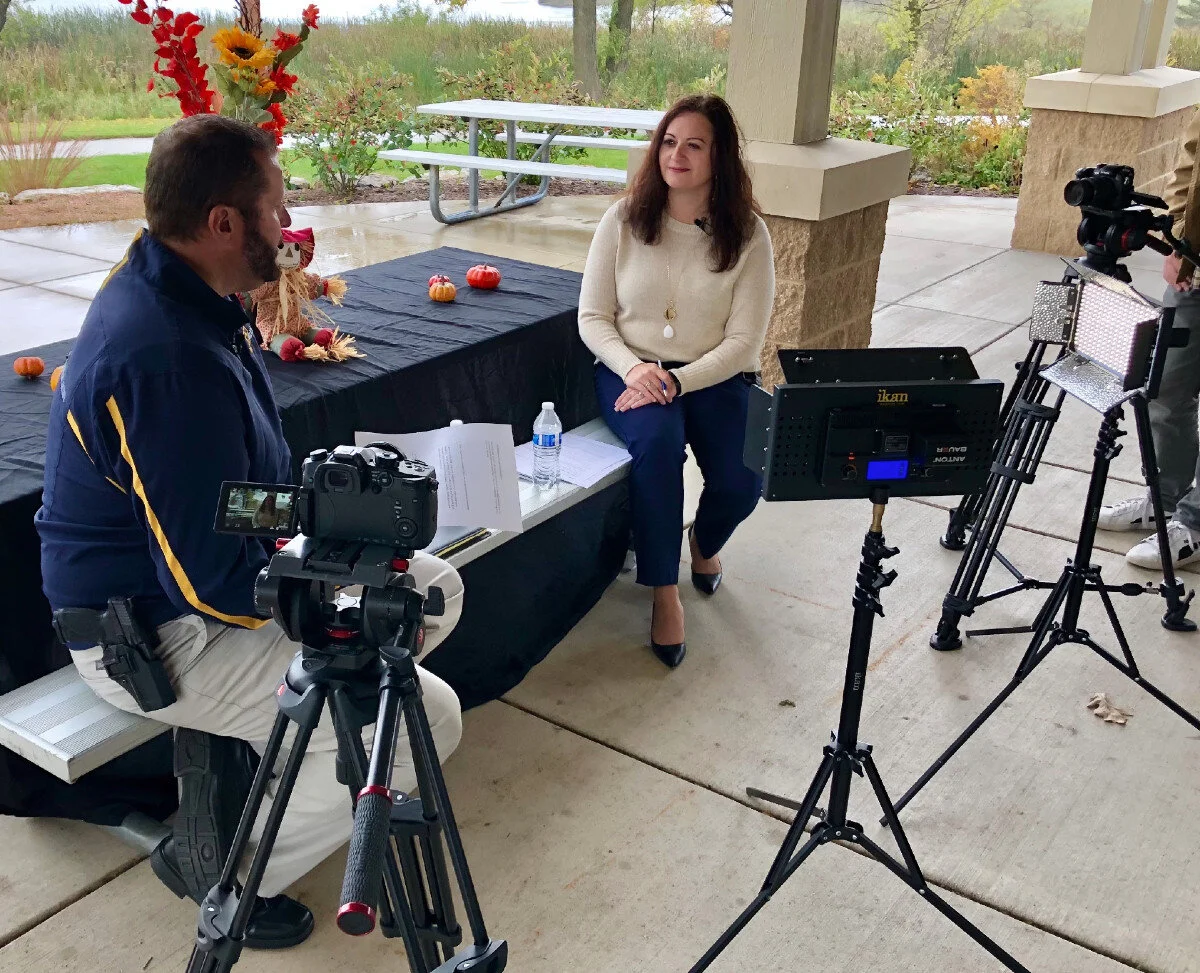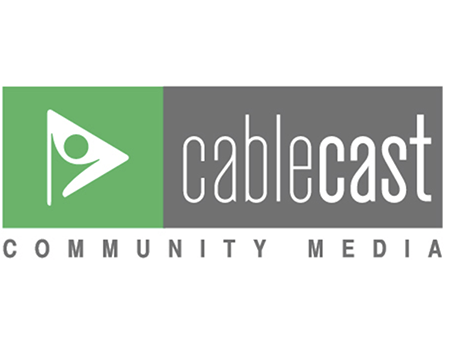The Village of McFarland Communications and Technology Department: Nick Boucher, Patrick Heasty, Stephanie Miller, Ben Becs and Andrew Day.
The close-knit communications team from the Village of McFarland was covering a McFarland high school football game this week, one of many they will do this fall to bring the action into the homes of community residents. "We help people feel grounded in their community and have a stake in its success,” said Stephanie Miller, Director of the Department of Communications and Technology. “Our work here brings the community together, keeps people informed, and encourages residents to get involved.”
The Village of McFarland is a suburb of Madison, and most residents work in Madison or in one of the surrounding communities. “McFarland residents are very proud of their school district, the parks, and all the things that go on here that make it a great community to live in,” said Stephanie.
Focus
The department focuses on school district events, local government, and library presentations, but it also covers community events like parades – although the pandemic has brought these events to a virtual standstill. For the school district, it covers school board meetings and an array of high school sports. For the village, the department broadcasts every government meeting from the Village Board on down.
A few years ago, the Village Board mandated that all meetings be covered either live or, if necessary, on a recorded basis. WMCF typically covers 15 meetings a month for about twenty government boards and committees. Sometimes the staff admittedly gets a bit weary and wonders if people really care. “Then we’ll get these calls, ‘where is the meeting? It was on the schedule. I was planning to watch it this evening.’ I tell my staff, ‘It may not seem like our work is being recognized, but what we do matters. We do have an audience,’” said Stephanie.
Role during the pandemic
The role of the Communications and Technology Department shifted during the pandemic as events were cancelled and meetings went virtual. WMCF stepped in as they could to help things continue on a little bit like normal. For example, due to the pandemic, the annual Fire & Rescue open house was cancelled during Fire Prevention Week. Instead, WMCF did a 45-minute walking tour of the fire bay just like an open house. “It is still the number 2 hit on our YouTube channel,” said Stephanie. “If you have little kids, it’s fun to watch. Actually, it’s rewarding for all ages!”
Senior Outreach employees asked WMCF to offer programming for seniors – something they could look forward to during the pandemic. Every first and third Friday of the month, WMCF features a public domain film or program on cable and on its livestreamed website. A Senior Outreach employee is recorded reading announcements about upcoming events and providing a little background about the film before each. “It works really well to entertain as well as to inform and encourage participation in activities,” said Stephanie.
Encouraging and reaching residents
Lately, the WMCF team has been looking for ways to encourage the public to get more involved. “Making McFarland” is a new series that WMCF will be producing at the suggestion of a resident. Stephanie hopes that understanding how municipal government works will also encourage more participation. Each episode will focus on a different village department and explain what it does. The resident is planning to help with the production by developing scripts and questions for eight village departments.
The communication team recognizes that everyone consumes media differently. That’s why the village not only uses cable television, whose subscribership has declined substantially from a high of almost 80% of households at the beginning of the century, to using other platforms. The department uses Facebook and Instagram to reach social media users and the Village website to reach viewers who like going to a website to read, livestream programming, or view shows on demand. The department also sends out a bi-weekly email to reach another sector of the community and publishes a print newsletter three times each year. Stephanie said, “One of the questions we’ve been asking ourselves is how many platforms do we need to reach all of our audiences? In 2022, we’re looking at Roku. We always have to consider how we’re going to get the attention of viewers and how we will do against the alternatives they have to watch.”
History
McFarland WMCF Cable 12 was established in 1978 as a local education and government (EG) access television channel on the Charter cable TV system. When the Wisconsin state legislature deregulated cable television in 2007, Charter moved WMCF from channel 12 to digital 982 that could only be viewed by digital subscribers or not quite half of its customers at that time. A quick challenge by Wisconsin Community Media pushed Charter to make Wisconsin’s PEG channels also available to its analog-only customers. As a result, Charter put WMCF on analog channel 98 in addition to 982 for several years until it converted its whole system to digital.
Initially, one part-time city employee, Brian Utter, managed WMCF with the help of a group of volunteers. Over time, the number of part-time staff increased to six as the communication needs of the village expanded into data transmission and village communications generally. Stephanie said, “Even today people still call our department ‘the cable people,’ even though we do a lot more than cable now.”
Today, while the mission of the department remains the same, it has more staff, more responsibility, and more ways to fulfill it. After years of staffing the department with part-timers, the village elevated two key part-time employees to full-time in 2018 after the part-time director, Eric Redding, left. Formerly the social media specialist, Stephanie became the full-time director and quickly succeeded in getting the village to make Andrew Day, who Stephanie called the “infrastructure czar” full-time too. “Andrew is such an important player. He knows the village’s systems inside and out. The village just couldn’t afford to lose him!” she said. In addition, two part-time production positions were consolidated into one full-time position. Today the Communications and Technology Department has three full-time employees and two part-time employees. The Communications and Technology Department also has a committee that meets as needed, perhaps five or six times each year to discuss policy issues. Of the nine members, two are village trustees.
“Our staff is definitely like a family,” said Stephanie. When everyone was part-time, it was not uncommon for someone to leave when they landed a full-time job. “It was a sad moment when we lost people,” said Stephanie. But since the shift to a mostly full-time staff, no one has left. “I look forward to seeing my colleagues every day. We’ve definitely bonded.”
Relationship with TDS and Charter Spectrum
TDS began serving McFarland in 2019 with cable television, telephone and broadband service. Offering an alternative to Charter Spectrum, TDS immediately offered to carry WMCF in HD (high definition). Stephanie said TDS was “shocked” to learn that Charter was still carrying WMCF in the antiquated SD (standard definition) format. “They’re twenty years behind the times,” said one TDS technician. All TDS customers receive WMCF in HD on channel 1009 and the WMCF staff is thrilled. “TDS is great to work with,” said Stephanie. “There is such a contrast between the way the two companies handle our signal. At the office we have one monitor showing WMCF as Charter degrades it and the same kind of monitor showing what our station looks like on TDS. Just seeing the quality difference makes us sad. Charter Spectrum subscribers are not getting the full quality that is being put into the programming we produce. All the work we put into our shows, the great HD equipment we use – it just shines through on the TDS system and when we see how we look on Charter, well it’s just a big wet blanket.”
“Our team works really hard to bring our community to life,” said Stephanie. “We are always going to be here covering McFarland. We will always be encouraging people to get involved. We provide content in the highest quality we can to draw our audiences in, so it’s particularly frustrating that [Charter] Spectrum won’t play us in HD.”
On top of the innate inferior quality of SD, Stephanie said there is an “audible hum that is forever on our channel.” She said that she has finally stopped calling Charter about it because Charter basically told her in so many words that “they weren’t going to deal with it anymore.” Stephanie said the thing that really irks her is that people think it’s WMCF’s fault, not Charter’s. There was also an extended outage recently. It happened around the same time that three other PEG access stations in the state were experiencing outages on Charter Spectrum systems. WMCF’s channel was black for five days starting on Monday, September 13. “We called Charter right away, and they said they would look into it. We had to revise our promotions to tell our Charter customers that they would not be able to see our throwback Thursday programming and the two high school games -- volleyball and football -- that had been scheduled. “We didn’t hear from them all week and then suddenly we were back up on Friday. We still have received no explanation from Charter.”
Internship opportunities at WMCF
Stephanie has a degree in Communication Arts from UW-Madison with a focus in Radio/TV/Film. “I had no experience in community media when I moved to McFarland, but I knew people through my production work that had gone to McFarland schools and had started out in the business as volunteers at WMCF. I believe all students should have the opportunity to take media production classes in high school. I think about how I wanted to take television production and journalism courses in high school like my brother. But when I got to high school – I grew up in Wausau -- there weren’t enough kids interested in these classes so they were cancelled. Instead, my friends and I would take cameras out and make movies on our own.”
While WMCF does not offer video production training to the public at large, it does offer student internships. “I want to make sure McFarland students continue to have the opportunity to work here at WMCF,” said Stephanie. Patrick Heasty began working at WMCF in 8th grade and five years later he is still working part-time at WMCF while attending Madison College with plans to major in computer engineering. “Patrick is really talented. He’s not only a great cameraperson, but he’s built and rebuilt our editing computers. Last year was a proud moment when he took home an award in the fest.” Patrick won an Achievement Award in the Best of the Midwest Media Fest for “Senior Outreach Holiday Special 2020 featuring John Duggleby” in the professional Performing Arts category.
How to find communications from the Village of McFarland
You can like, follow, and subscribe to the McFarland Communications and Technology Department communications in a variety of ways!
Cable subscribers in eastern Dane County can view WMCF in HD on TDS channel 1009 and on Spectrum (Charter) in SD on cable channel 982.
If you don’t subscribe to cable, you can view a livestream of the channels at www.mcfarlandcablechannel.com.
You can also see Village posts and videos at the following spots:
· YouTube: www.youtube.com/mcfarlandcable
· Facebook: @villageofmcfarlandwi
· Instagram: @villageofmcfarland
· Website: www.mcfarland.wi.us
You can also take a look at the village’s newsletter at www.mcfarland.wi.us/enewsletter

















